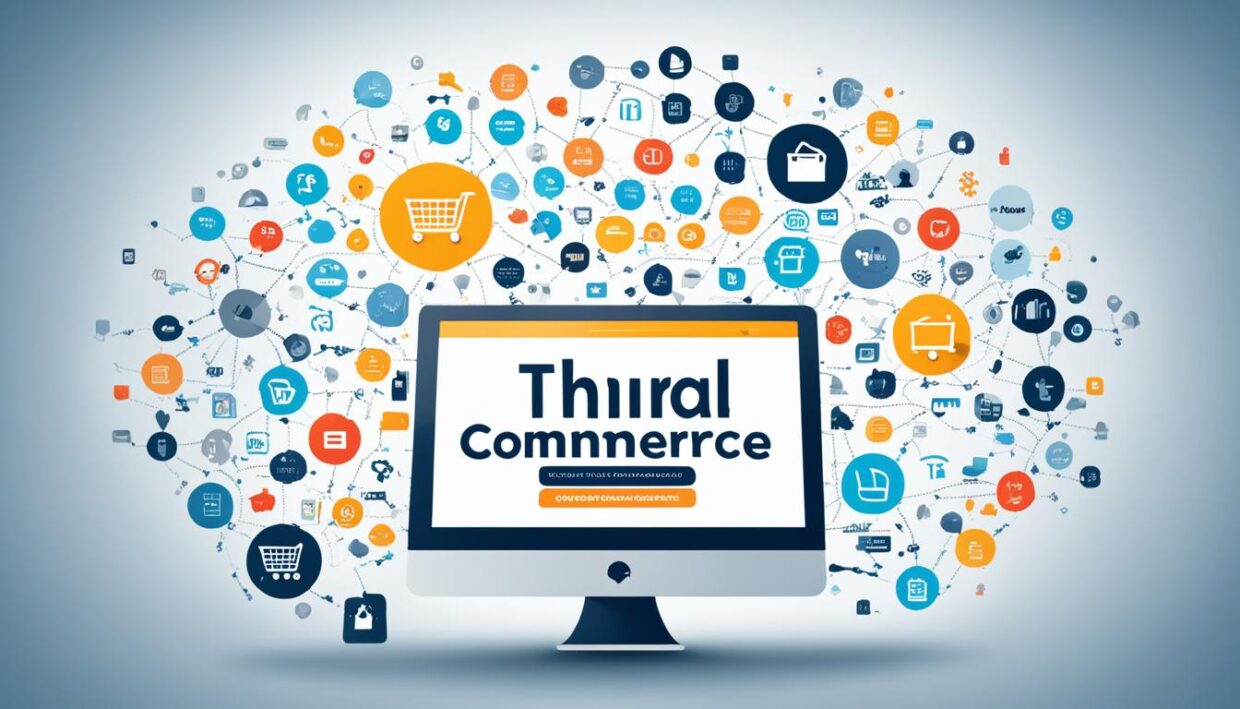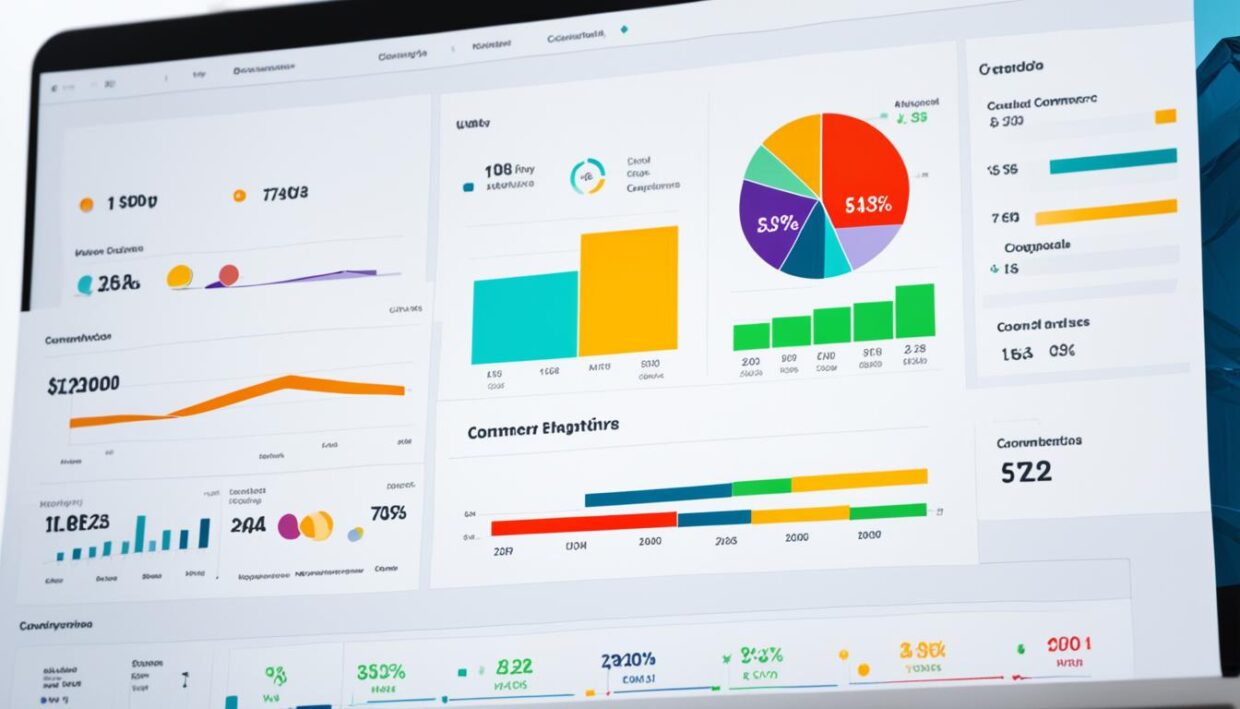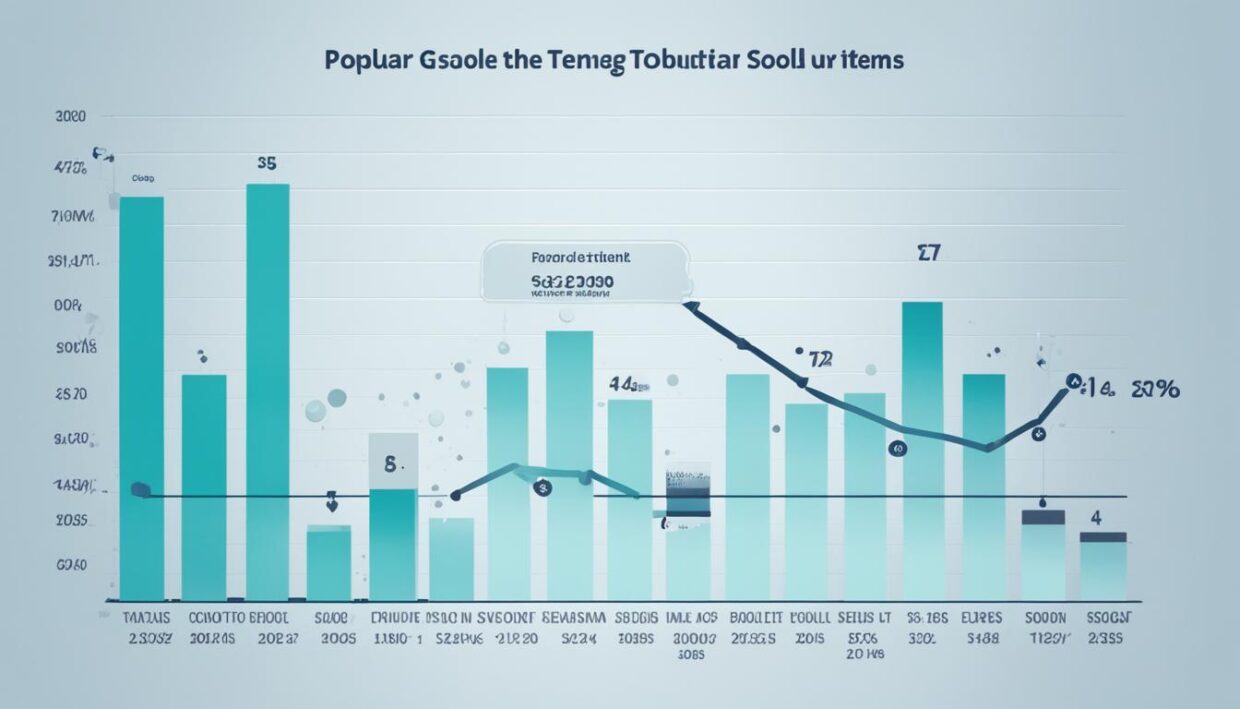
“The best way to predict the future is to create it.” – Peter Drucker. This powerful quote captures the essence of starting your own e-commerce journey. In today’s digital age, launching an online store has never been more accessible, with projected global e-commerce sales soaring to a staggering $6.3 trillion by 2024. This comprehensive guide on online store creation will walk you through the essential steps to start an e-commerce store, from understanding the landscape to developing your business strategy.
With relatively low upfront costs, a robust business idea, and a user-friendly e-commerce platform, aspiring entrepreneurs can establish a successful online venture. Throughout this article, you will discover invaluable insights about the benefits of e-commerce, effective niche identification, competitor analysis, and much more, paving your way toward e-commerce website development success.
Key Takeaways
- Global e-commerce sales are poised to reach $6.3 trillion by 2024.
- Understanding different e-commerce models is crucial for business success.
- Effective business registration involves selecting a suitable legal structure.
- Choosing the right e-commerce platform is vital for streamlined operations.
- Identifying your target market can significantly enhance profitability.
- Utilizing various delivery methods can improve customer satisfaction.
- Adopting diverse marketing strategies will help to promote your online store effectively.
Understanding the E-commerce Landscape
The e-commerce landscape consists of various models such as Business-to-Consumer (B2C), Business-to-Business (B2B), Consumer-to-Consumer (C2C), and Consumer-to-Business (C2B). This diversity allows sellers to customize their approaches based on their target market and product offerings. Successful sellers often concentrate on specific niches. Focusing on well-defined niches leads to fewer competitors, thereby increasing the potential for success.
As of 2023, e-commerce accounted for 15.4% of total retail sales in the U.S., reflecting a significant evolution from previous years. For example, in 2018, e-commerce represented just 9.7% of total sales, showcasing rapid growth in the online business market. Analysts project continued expansion, emphasizing the importance of understanding market dynamics, consumer behavior, and emerging trends.
Innovative companies like Touchland have successfully transformed basic products, such as hand sanitizer, into fashionable items. This showcases the power of identifying consumer needs and wants while ensuring profitability. Various e-commerce shipping strategies, including Direct-to-Consumer (DTC) and Dropshipping, present different advantages, catering to diverse business models.
As companies explore the online business market, they must take into account their shipping strategy and initial investment requirements. A business plan should encompass essential components such as business description, mission statement, competitor research, product descriptions, and financial projections. Selecting the right e-commerce platform is also crucial, with options like Shopify and WooCommerce being popular among startups.

Additionally, the mix of physical and online platforms, referred to as the “click and mortar” approach, has become an essential strategy for modern retailers. E-commerce encompasses a wide range of models and methods, making it imperative for businesses to adapt and thrive in this dynamic environment.
Benefits of Starting an Online Business
Launching an e-commerce venture comes with numerous benefits of online business that appeal to aspiring entrepreneurs. The digital landscape offers flexibility and the capacity to reach a global audience, presenting significant advantages of e-commerce. With 60.87% of individuals aiming to become their own boss and 47.64% feeling frustrated with corporate jobs, the desire for independence grows.
Operating an online business allows for 24/7 availability, granting customers the freedom to shop at their convenience. This continuous accessibility often results in increased sales and revenue. Furthermore, digital marketing channels enable businesses to reach a wide audience at a lower cost, enhancing sustainability. By leveraging these channels, entrepreneurs can expand their reach while minimizing marketing expenses.

One of the most compelling aspects of selling products online is the reduced overhead costs. Unlike traditional retail establishments, online businesses do not incur expenses related to physical space, such as facilities management or cleaning services. Notably, small business owners typically allocate 31.6% of their first-year budget to inventory and manufacturing, with minimal need for additional resources like shipping or warehouse rents.
Moreover, the international reach of e-commerce is striking. With global trade valued at $25.8 trillion, the potential for customer acquisition is vast. Flexibility extends beyond hours of operation; it includes the ability to hire talent from a global marketplace, optimizing labor costs significantly.
The growth trajectory for e-commerce is impressive, with projections suggesting it will account for 25% of global retail sales by 2025. Enhanced customer support through online platforms also contributes to improved customer satisfaction, leading to increased repeat business. These benefits illustrate why more entrepreneurs are shifting towards digital solutions and embracing the potential of online business.
| Benefit | Details |
|---|---|
| Flexibility | Manage operations from anywhere with an internet connection. |
| Cost Efficiency | Lower operating costs compared to physical stores. |
| Global Reach | Access to a vast customer base and workforce. |
| 24/7 Availability | Customers can shop any time, increasing potential sales. |
| Marketing Opportunities | Access to digital channels at lower costs. |
Finding Your Niche in E-commerce
Finding a viable e-commerce niche is essential for establishing a successful online business. With less than a million online stores achieving more than $1,000 in monthly sales, effective niche market identification becomes crucial. Factors driving this identification include profitability, unique product opportunities, and personal passion for specific products.
Many successful companies illustrate the importance of selecting the right niche. For example, FLEO Shorts expanded its popular Crossfit shorts into related categories through thoughtful market exploration. Touchland, during the COVID-19 pandemic, sold 10,000 dispensers in just three months, demonstrating the potential of identifying and targeting specific consumer needs. Additionally, a Year of Dates started as a unique gift idea and achieved global sales, showcasing the power of innovation in product selection.

High-demand trends like probiotics, specialty teas, and eco-friendly products reflect growing interests that entrepreneurs should consider. Niche markets typically feature less competition compared to broader markets, making it easier for newcomers to establish a foothold. The natural and organic beauty sector exemplifies this, as it grew by 10% year-on-year in 2019 and is projected to reach $54 billion by 2027.
Research becomes a vital component of validating niche ideas. Using tools like Google Trends, SEMrush, and Google Keyword Planner permits entrepreneurs to uncover trending products and popular search terms, guiding their SEO strategy. Creating detailed buyer personas enables a better understanding of potential customers, ensuring niche selection aligns with their needs and preferences.
| Niche | Market Growth | Consumer Interest | Product Opportunities |
|---|---|---|---|
| Health and Wellness | Continuously growing | High | Fitness products and supplements |
| Pet Care | $72 billion annually | Strong | Grooming products, toys, and food |
| Minimalist Jewelry | Increasing interest | Growing | Unique designs and custom pieces |
| Eco-friendly Products | Rising demand | High | Sustainable alternatives and goods |
| Subscription Boxes | Popular trend | Very High | Curated selections in various niches |
The potential for lucrative opportunities in niche markets encourages entrepreneurs to explore various options for e-commerce success. Investing time in researching, identifying, and validating a niche will ultimately lead to a thriving online business.
Researching Competitors and Writing a Business Plan
In the fast-evolving landscape of e-commerce, conducting thorough competitor analysis is essential for differentiation. Entrepreneurs must systematically evaluate their primary, secondary, and tertiary competitors, focusing on market positioning and product similarities. Performing a SWOT analysis within this context helps to unveil strengths, weaknesses, opportunities, and potential threats, guiding strategic decisions effectively.
A solid approach to business plan development starts with defining clear goals tailored to upgrade marketing strategies, enhance brand presence, and increase conversion rates. These objectives will directly inform the marketing plan, emphasizing key metrics such as customer acquisition cost (CAC) and customer lifetime value (CLV). Regularly monitoring these metrics through market research maintains alignment with the overall goals of the e-commerce store.
Utilizing robust tools for competitor analysis, such as SEO resources or social media insights, provides market trends understanding and aids in identifying growth opportunities. By scrutinizing competitors’ marketing strategies, merchants can adopt successful tactics while developing their unique value propositions, ensuring that they remain competitive in a saturated landscape.
The e-commerce sector, projected to reach an $8 trillion market share, demands a focused business plan that helps navigate the competitive environment. With approximately 67% of clicks directed to the top search engine results, a well-constructed online presence supported by insightful market research enhances visibility and customer engagement.

Picking the Right Product Line
Selecting the appropriate product line plays a vital role in establishing a successful e-commerce venture. Conducting thorough market demand assessment enables entrepreneurs to pinpoint specific consumer needs and preferences. By focusing on emerging trends and consumer interests, businesses can effectively streamline product offerings that resonate with their target audience.
Identifying Profitable Products
A key component of profitable products identification involves understanding which items have the potential to yield higher margins. Researching niche products can lead to higher success rates than offering broad ranges of goods. Establishing a limited inventory centered around a specific area allows for a more targeted marketing approach, making it easier to attract dedicated customers.
Using tools like Google Trends and competitor analysis helps businesses evaluate current consumer interests and price points, providing invaluable insights into product viability. Attending tradeshows can also aid in discovering unique items not widely available in conventional retail stores like Target or Walmart.
Assessing Market Demand
The significance of accurate market demand assessment cannot be overstated. Tracking e-commerce statistics reveals that there are approximately 263 million digital buyers in the U.S., with projections to rise to 291.2 million by 2025. This expansion opens opportunities for businesses that concentrate on specialized product lines.
Utilizing visual elements plays an essential role in online sales; 40% of shoppers favor images, while 21% value videos. Owners of online stores should ensure their product presentations are visually appealing to engage consumers effectively. By creating clear return policies and providing excellent customer service, e-commerce businesses can foster trust and enhance customer loyalty, ultimately boosting their profitability.

Choosing a Business Name and Creating a Brand Identity
A strong brand identity forms the backbone of any successful e-commerce venture. The business name choice plays a pivotal role in conveying your mission and values while resonating with your target audience. Research shows it takes five to seven impressions for customers to remember a brand, yet only seven seconds to form an initial impression. This emphasizes the need for a memorable and meaningful business name.
When selecting a name, consider the type of branding you want to establish, whether descriptive, suggestive, or arbitrary. Descriptive names serve to clarify a brand’s positioning, yet may lack the memorability of more creative options. Suggestive names can evoke specific feelings and are often easier to trademark due to their originality. Arbitrary names may serve well in certain contexts but might lack meaningful connections for consumers.
Effective brand identity development aligns with the characteristics of your target demographic and industry. Engaging in market research and soliciting feedback from potential customers can ensure a well-received name that sticks. Tools like online name generators can offer a wealth of ideas based on selected keywords.
It is essential to check the availability of your chosen name across domains and social media to maintain branding consistency. The .com extension remains a preferred choice, as it’s widely recognized and easier to remember. Matching your domain with your business name can enhance SEO capabilities and lead to improved brand awareness.
The following table outlines different types of business names and their respective characteristics:
| Type of Name | Description | Memorability | Trademark Potential |
|---|---|---|---|
| Descriptive | Clearly indicates the business offering | Moderate | Lower |
| Suggestive | Evokes emotions and feelings | High | Higher |
| Arbitrary | Lacks direct meaning but can be effective | Lower | Varies |
Incorporating keywords into your domain name can enhance SEO while making it easier for customers to find your e-commerce store. The ideal business name should be short, catchy, and reflective of what your business does, ensuring it resonates with your target audience.

Register Your Business for E-commerce
Establishing a legal foundation for your e-commerce venture is essential. This process begins with business registration, which involves selecting an appropriate business structure. Business structure selection can have significant implications for liability, taxes, and overall operations.
Understanding Business Structures
Choosing the right business structure is vital for e-commerce owners. Common options include:
- Limited Liability Company (LLC): Offers liability protection and flexible tax treatment.
- Corporation: Suitable for larger operations with potential investors, also provides liability protection.
- Sole Proprietorship: Easiest to set up but offers less personal liability protection.
When considering business registration, obtaining an Employer Identification Number (EIN) is necessary for tax obligations. Researching local and state requirements will ensure compliance with regulations.
Obtaining Necessary Licenses and Permits
Acquiring the appropriate licenses for e-commerce is crucial for legal operation. Entrepreneurs should identify specific licenses required in their industry and location. This may involve:
- Securing a general business license.
- Obtaining sales tax permits for collecting taxes.
- Meeting any additional local regulatory needs, especially if operating from home.
It’s essential to renew business licenses annually to maintain compliance. Utilizing resources such as the Small Business Association can guide entrepreneurs in navigating the licensing process, helping avoid potential fines and ensuring legitimacy.

Selecting an E-commerce Platform
Choosing the right e-commerce platform is pivotal for the success of any online business. The process of e-commerce platform selection involves evaluating various options available in the ecosystem. Popular platforms such as Shopify, BigCommerce, and WooCommerce present a spectrum of features and pricing structures to cater to different business needs.
Comparing Popular E-commerce Platforms
To make an informed decision, conducting a thorough platform comparison is essential. Each provider offers unique benefits:
- Shopify: Known for its user-friendly interface and extensive app ecosystem. Recently, it raised its Shopify Plus fixed monthly fee by 25%, which can influence pricing evaluation.
- BigCommerce: Offers a range of integrated features, including Multi-Storefront functionality, which aids in managing multiple storefronts efficiently. Forrester Consulting reports that regular customers tend to break even eight months after launch and achieve a 211% ROI by year three.
- WooCommerce: This WordPress-based solution provides flexibility and customization but may require more technical knowledge compared to other platforms.
Evaluating Features and Pricing
Evaluating features and pricing is a critical aspect of e-commerce platform selection. Factors to scrutinize include:
- Ease of use and setup times, with some platforms allowing site launches in as little as four months.
- Customization options that align with your brand identity and enable effective customer engagement.
- Payment gateway integrations for seamless transactions and cost management.
- Total Cost of Ownership (TCO), which includes initial fees, transaction costs, and potential future expenses to ensure a comprehensive pricing evaluation.

As the eCommerce market is poised for growth, projected to surpass $8 billion by 2025, making the right choice in this phase is crucial for long-term success. Careful consideration of these elements will help steer your online venture toward profitability while navigating through the complexities of platform selection.
Building Your E-commerce Website
Creating an effective e-commerce website is crucial in today’s competitive landscape. Website building involves choosing the suitable domain name and an engaging template that aligns with your brand identity. Understanding the essential elements of a successful e-commerce website can significantly influence your online sales and customer satisfaction.
Essential Elements of an E-commerce Website
Several components make up the e-commerce website essentials. These include:
- Compelling Product Descriptions: Clearly written and engaging descriptions enhance the appeal of your products.
- User-Friendly Navigation: Easy-to-use layouts help customers find what they need quickly, improving overall site functionality.
- Secure Payment Processing: Ensuring safe transactions increases customer trust and encourages repeat purchases.
Integrating E-commerce Functionality
Integrating critical functionalities can enhance your site’s performance while creating a seamless shopping experience. Consider the following:
- Inventory Management: Efficient tracking of stock levels keeps customers updated and prevents overselling.
- Customer Reviews: Displaying user feedback builds credibility and assists new customers in making informed purchase decisions.
- Mobile Optimization: With many consumers shopping via mobile devices, ensuring your website is optimized for mobile use enhances the user experience.

Start an E-commerce Store: Setting Up Payment Processes
Establishing effective payment processes is essential for any online business. A reliable payment setup not only enhances customer experience but also boosts trust in the platform. Payment gateways like PayPal and Stripe serve as vital tools for facilitating secure transactions. Understanding the transaction fees involved with these gateways can significantly influence the overall profitability of your business.
Payment Gateway Integration
Integrating a payment gateway involves selecting the right service provider that meets your business needs. Consider these factors when choosing a payment gateway:
- Security: Ensure the gateway provides robust security measures to protect customer data.
- Transaction Fees: Look for competitive rates. Transaction fees typically range between 1% to 5%, along with a flat fee of about 25 cents.
- Payment Methods: Verify that the gateway supports your customers’ preferred payment methods, as 11% of users abandon carts if their choice is unavailable.
- Mobile Compatibility: With half of all e-commerce transactions occurring via mobile devices, a mobile-friendly gateway is necessary.
Understanding Transaction Fees
Transaction fees can vary widely, impacting your bottom line. Set-up costs for e-commerce payment processors may range between free and $250, with monthly fees running from $10 to $50. Businesses must evaluate how these fees align with their budget and pricing strategy.
| Payment Gateway | Set-Up Cost | Monthly Fee | Transaction Fees |
|---|---|---|---|
| PayPal | Free | $0 – $30 | 2.9% + $0.30 |
| Stripe | Free | $0 – $50 | 2.9% + $0.25 |
| Shopify Payments | Free | $29 – $79 | 2.9% + $0.00 |

Being informed about payment gateways and their associated transaction fees ensures a smooth shopping experience for your customers while safeguarding your revenue. Such strategic planning is crucial for sustaining a successful e-commerce operation.
Implementing Inventory Management Systems
A robust inventory management system plays a critical role in the success of any e-commerce business. These systems aid in tracking product levels and managing stock replenishment, which directly impacts operational efficiency. Tools like QuickBooks Commerce and TradeGecko demonstrate the effectiveness of inventory management systems by helping businesses avoid stockouts and maintain accurate product counts.
Many small businesses still rely on manual methods for stock control. According to Wasp, 43% of these businesses face risks associated with outdated tracking. To combat such issues, integrating modern inventory tools allows for enhanced visibility and precision in tracking sales orders. Implementing strategies like FIFO (First In First Out) helps sell older stock first, reducing the likelihood of outdated inventory accumulating.
Incorporating the ABC classification method optimizes stock management by categorizing products. This method highlights that A items contribute to 80% of revenue but represent only 20% of stock. The awareness generated by these statistics enables businesses to focus on high-value items while efficiently managing a diverse product range.
Maintaining safety stock, commonly calculated with a formula that factors in maximum daily usage and lead time, acts as a buffer against unforeseen demand shifts. This proactive strategy prevents stock-outs and ensures customer satisfaction. Techniques such as kitting can also aid in offloading slow-moving stock while promoting higher order values through attractive offers.
To maintain relevance in today’s competitive landscape, e-commerce enterprises must employ effective inventory management systems. The growing reliance on streamlined processes leads to improved customer retention, as noted by Bain and Company, where even a 5% increase in retention could translate to a 25% profit increase.

Establishing Shipping and Fulfillment Strategies
Effective shipping and fulfillment strategies are essential for the success of any e-commerce business. Customers expect quick and affordable delivery options, making it vital for online retailers to assess their shipping methods thoroughly. By considering various fulfillment options, businesses can enhance customer satisfaction and drive repeat purchases. This section will explore the best shipping options available and discuss how to manage e-commerce logistics effectively.
Choosing the Best Shipping Options
The right shipping strategies can significantly reduce cart abandonment rates. Research shows that 61% of shoppers abandon their carts when shipping costs become too high. Offering free or affordable shipping can be a game changer. Businesses can blend different fulfillment options such as in-house order fulfillment and dropshipping to meet customer demands while keeping costs low.
- In-house order fulfillment for greater control over shipping time and costs.
- Dropshipping to minimize inventory risks and streamline processes.
- Partnering with third-party logistics providers to handle shipping and fulfillment efficiently.
Additionally, services like Deliverr for 2-day delivery can appeal to customers who prioritize fast shipping. Offering clear pricing through shipping calculators can enhance transparency, allowing customers to make informed decisions before checkout.
Managing Logistics for E-commerce
Efficient e-commerce logistics management is crucial in optimizing delivery times. Businesses should evaluate their order fulfillment processes, which typically include receiving inventory, warehousing products, order processing, and returns management. These steps are vital for a smooth shipping experience.
Statistics reveal that 53% of shoppers consider delivery speed an important factor when evaluating online orders. Furthermore, 38% of shoppers will not shop with a retailer again after a poor delivery experience. By establishing reliable partnerships with shipping carriers and choosing the right logistics services, e-commerce businesses can avoid issues that lead to lost customers.
Utilizing third-party logistics providers, like Fulfilled by Amazon (FBA), can also support multi-channel fulfillment, ensuring products reach customers in a timely and dependable manner. Ultimately, combining effective shipping options with robust e-commerce logistics can bolster customer loyalty and improve overall sales performance.

Developing Effective E-commerce Marketing Strategies
Establishing a successful online business involves not only creating a great product but also effectively reaching and engaging potential customers. Implementing robust e-commerce marketing strategies remains critical in attracting and retaining clients. Social media marketing, email marketing, and influencer partnerships each play unique roles in building brand awareness and driving traffic to your online store.
Utilizing Social Media Marketing
Social media platforms present an unparalleled opportunity for businesses to connect with a vast audience. With over 2.9 billion monthly active users on Facebook, brands can foster community engagement by sharing valuable content. Utilizing visually appealing platforms like Instagram provides a direct path to purchase via product integration in posts and Stories. A majority of consumers express a preference for video content, making it essential to tailor strategies that leverage this format. Moreover, with 75.3% of customers seeking social proof through testimonials, it’s vital to showcase client feedback to enhance brand credibility.
Incorporating Email Marketing Techniques
Email marketing remains a powerful tool for nurturing relationships with customers. Automated email campaigns can target specific segments with personalized messages, such as reminders for abandoned shopping carts. A strategy exemplified by Alex Mill, which offers a 15%-off incentive, can effectively encourage conversion. Businesses can increase engagement rates through tailored email promotions, providing value directly to the customer’s inbox.
Leveraging Influencer Partnerships
Influencer marketing provides an innovative approach to reach new audiences while creating authentic brand connections. Companies leverage influential figures as an alternative to traditional paid advertising, finding that 85% of marketers deem it effective. Platforms like TikTok, known for their engaging user interfaces, allow brands to utilize influencer partnerships to captivate younger demographics effectively. As brands chart their paths with influencers, they tap into established trust and authority, driving sales and expanding reach.

| Marketing Strategy | Key Benefits | Stats/Insights |
|---|---|---|
| Social Media Marketing | Wide reach, community engagement, brand awareness | 2.9 billion Facebook users |
| Email Marketing | Direct communication, personalized offers, cart recovery | 70.19% of carts are abandoned |
| Influencer Partnerships | Authentic connections, access to new audiences | 85% of marketers find it effective |
Providing Excellent Customer Service for Online Stores
Ensuring outstanding customer service for online stores significantly impacts customer experience. Studies show that 65% of consumers prefer brands that enable conversation across channels, indicating the importance of multi-channel support in e-commerce. Retailers must adopt service strategies that create seamless experiences to build customer loyalty.
Online retailers can utilize various platforms like Zendesk, which offers over 1,000 pre-built integrations tailored to enhance customer service for online stores. Utilizing a combination of messaging, live chat, and social media support fosters deeper connections with consumers. This accessibility aids in retaining customers who might otherwise seek alternatives.
To excel, retailers should focus on specific strategies. Providing detailed information on shipping, return policies, and warranties reduces conflicts. High-quality site search enhances satisfaction, enabling customers to locate what they need effortlessly. Offering free shipping can impress consumers, driving sales while ensuring a positive customer experience.
Additionally, following up with customers post-purchase demonstrates care and creates opportunities for repeat business. According to statistics, 77% of consumers argue that good customer service is vital for brand loyalty. By actively listening and empathizing with customers, retailers can foster better interactions and encourage customer delight.
| Customer Service Strategy | Benefits |
|---|---|
| Multi-channel support | Increases engagement and customer retention |
| High-quality site search | Improves satisfaction and conversion rates |
| Free shipping | Encourages purchases and customer loyalty |
| Post-purchase follow-ups | Promotes repeat business and customer retention |

Tracking Performance and Analytics
To succeed in the competitive e-commerce market, performance tracking through robust e-commerce analytics is essential. Implementing effective analytics tools, such as Google Analytics, allows businesses to understand customer behavior, track sales performance, and gauge the effectiveness of marketing campaigns. By identifying crucial Key Performance Indicators (KPIs) like conversion rates, average order value (AOV), and customer lifetime value (CLV), e-commerce businesses can obtain a clear picture of their performance.
Further metrics enhance the understanding of customer interactions. The following table provides insight into various crucial e-commerce metrics, highlighting their formulas and significance:
| Metric | Formula | Importance |
|---|---|---|
| Conversion Rate | (# of Purchases / # of Sessions) x 100 | Indicates the effectiveness of website traffic in generating sales. |
| Average Order Value (AOV) | Total Revenue / Total Number of Orders | Helps in understanding the average spend per transaction. |
| Customer Lifetime Value (CLV) | Average Value of a Purchase x # of Times the Customer Will Buy Each Year x Average Length of the Customer Relationship (in Years) | Provides insight into the long-term value of customers. |
| Cart Abandonment Rate | (# of Completed Purchases / # of Shopping Carts Created) x 100 | Indicates how often customers leave without completing their purchase. |
| Bounce Rate | Provided by Google Analytics | Measures the percentage of visitors who leave after viewing only one page. |
In addition to direct sales metrics, behavior insights derived from e-commerce analytics can help optimize marketing tactics. Monitoring the source of conversions assists in determining which marketing channels yield the best results. Custom audience segmentation based on customer data enables businesses to tailor their offerings, enhancing the overall customer experience.
Adopting a comprehensive approach to performance tracking facilitates informed decision-making and adaptability. Leaders in e-commerce should focus on identifying trends and patterns within their analytics. By prioritizing data segmentation based on various criteria like device type and customer behavior, businesses can uncover significant opportunities for growth and improvement.

Adapting to Market Trends
Understanding and responding to shifting market trends is vital for any e-commerce business aiming to thrive. Global e-commerce sales are conservatively projected to grow by 39% by 2027, highlighting the robust opportunity awaiting businesses that adapt effectively. The impact of technology on shopping behavior cannot be understated, as the number of augmented reality (AR) users in the U.S. is expected to exceed 100 million by the end of 2025.
Industry changes are manifesting in various ways; for instance, mobile commerce is anticipated to account for 62% of all e-commerce by 2027. This shift indicates a need for e-commerce adaptability in mobile optimization and user experience. Furthermore, as 110.4 million people are estimated to shop via social channels in 2024, leveraging social media platforms becomes imperative for brand visibility and customer engagement.
Consumer demands also reveal crucial market trends. Reports indicate that over 70% of shoppers express a willingness to pay more for sustainably produced goods. This aligns with the growing recognition among 57% of Gen Z and Millennials who consider sustainability important in their purchasing decisions. E-commerce strategies should reflect these values to resonate with their target demographics.
To keep pace with industry changes, e-commerce managers are encouraged to engage with a variety of resources. These can range from newsletters and podcasts that deliver insights from industry experts to participating in webinars and networking events that reveal the latest innovations. Engaging with online communities on platforms like Reddit and LinkedIn offers opportunities for sharing insights and tackling challenges collaboratively.
Experimentation with diverse tools like Shopify, Mailchimp, and Zendesk enhances operational efficiency and customer satisfaction. Utilizing a range of payment options can address concerns, as 13% of customers abandon their carts if they don’t see sufficient payment methods available. A multi-faceted approach is essential in navigating the dynamic e-commerce landscape effectively.

Conclusion
Starting an e-commerce store is a rewarding endeavor filled with numerous opportunities for creativity and online business growth. By carefully navigating each step—from selecting a niche to implementing effective marketing strategies—entrepreneurs can create a robust e-commerce presence that stands out in an increasingly competitive digital marketplace. With projections estimating e-commerce revenue in the U.S. to reach $476 billion by 2024, the potential for success is evident.
To achieve e-commerce success, it is crucial to recognize the importance of mobile user experience, as a significant portion of website traffic comes from mobile users. Utilizing effective online marketing strategies, including SEO and social media marketing, not only enhances visibility but also engages potential customers. Maintaining professionalism through diligent website management, customer service, and consistent order processing ensures a sustainable foundation for your online business.
Ultimately, thriving in the e-commerce landscape requires persistence and adaptability. By staying attuned to market trends and continuously optimizing your platform for user experience, you can transform your vision into a flourishing online business. As e-commerce evolves, the right approach will open doors to innovative shopping experiences that resonate with customers, setting the stage for long-term success.




















Be the first to leave a comment